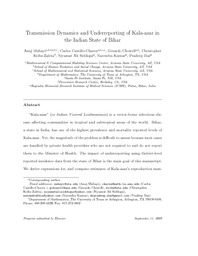
ATTENTION: The works hosted here are being migrated to a new repository that will consolidate resources, improve discoverability, and better show UTA's research impact on the global community. We will update authors as the migration progresses. Please see MavMatrix for more information.
Show simple item record
| dc.contributor.author | Kribs, Christopher | |
| dc.contributor.author | Mubayi, Anuj | |
| dc.contributor.author | Castillo-Chavez, Carlos | |
| dc.contributor.author | Chowell, Gerardo | |
| dc.contributor.author | Ali Siddiqui, Niyamat | |
| dc.contributor.author | Kumar, Narendra | |
| dc.contributor.author | Das, Pradeep | |
| dc.date.accessioned | 2016-05-11T20:00:37Z | |
| dc.date.available | 2016-05-11T20:00:37Z | |
| dc.date.issued | 2010 | |
| dc.identifier.citation | Published in the Journal of Theoretical Biology 262(1):177-185 | en_US |
| dc.identifier.uri | http://hdl.handle.net/10106/25666 | |
| dc.description | Author's final draft after peer review, also known as a post print. | en_US |
| dc.description.abstract | "Kala-azar" (or Indian Visceral Leishmaniasis) is a vector-borne infectious dis-
ease affecting communities in tropical and subtropical areas of the world. Bihar,
a state in India, has one of the highest prevalence and mortality reported levels of
Kala-azar. Yet, the magnitude of the problem is difficult to assess because most cases
are handled by private health providers who are not required to and do not report
them to the Ministry of Health. The impact of underreporting using district-level
reported incidence data from the state of Bihar is the main goal of this manuscript.
We derive expressions for, and compute estimates of Kala-azar's reproduction numbers, an indirect measure of disease prevalence, and levels of underreporting for the
21 districts of Bihar. The average reproduction number (number of secondary cases
generated per infective) estimates for Bihar range from 1.3 (2003) to 2.1 (2005) with
some districts' estimates with mean values lower than one. Model estimates (using
available data and a model-derived expression) show that the proportion of under-
reported cases declined from an average of 88% in 2003 to 73% in 2005. However, 8
districts in 2003 and 5 districts in 2005 had more than 90% levels of underreporting.
Model estimates are used to generate underreporting adjusted incidence rates. The
analysis finds that reported data misidentify four of the eight (2003) and three of
the nine (2005) districts classified as high-risk. In fact, seven (2003) and five (2005)
of the most affected Kala-azar districts had been classified as low-risk when only
reported incidence data were used. | en_US |
| dc.description.sponsorship | This work has been partially supported by a National Science Foundation (Grant DMS-0441114), National Security Agency (Grant H98230-05-1-0097), The Alfred P. Sloan Foundation (through the ASU-Sloan National Pipeline Program in Mathematical Science) and The Offi ce of the Provost of Arizona State University. | |
| dc.language.iso | en_US | en_US |
| dc.subject | Leishmaniasis | en_US |
| dc.subject | Mathematical models | en_US |
| dc.subject | Reproduction number | en_US |
| dc.subject | Private health care providers | en_US |
| dc.subject | Public health surveillance systems | en_US |
| dc.title | Transmission dynamics and underreporting of Kala-azar in the Indian State of Bihar | en_US |
| dc.type | Article | en_US |
| dc.publisher.department | Department of Mathematics, University of Texas at Arlington | |
| dc.identifier.externalLinkDescription | The original publication is available at Article DOI | |
| dc.identifier.doi | http://dx.doi:10.1016/j.jtbi.2009.09.012 | |
Files in this item
- Name:
- LeishUnderPreprint.pdf
- Size:
- 1.608Mb
- Format:
- PDF
- Description:
- PDF
This item appears in the following Collection(s)
Show simple item record


